engine DODGE VIPER 2008 ZB II / 2.G Workshop Manual
[x] Cancel search | Manufacturer: DODGE, Model Year: 2008, Model line: VIPER, Model: DODGE VIPER 2008 ZB II / 2.GPages: 303, PDF Size: 2.65 MB
Page 203 of 303
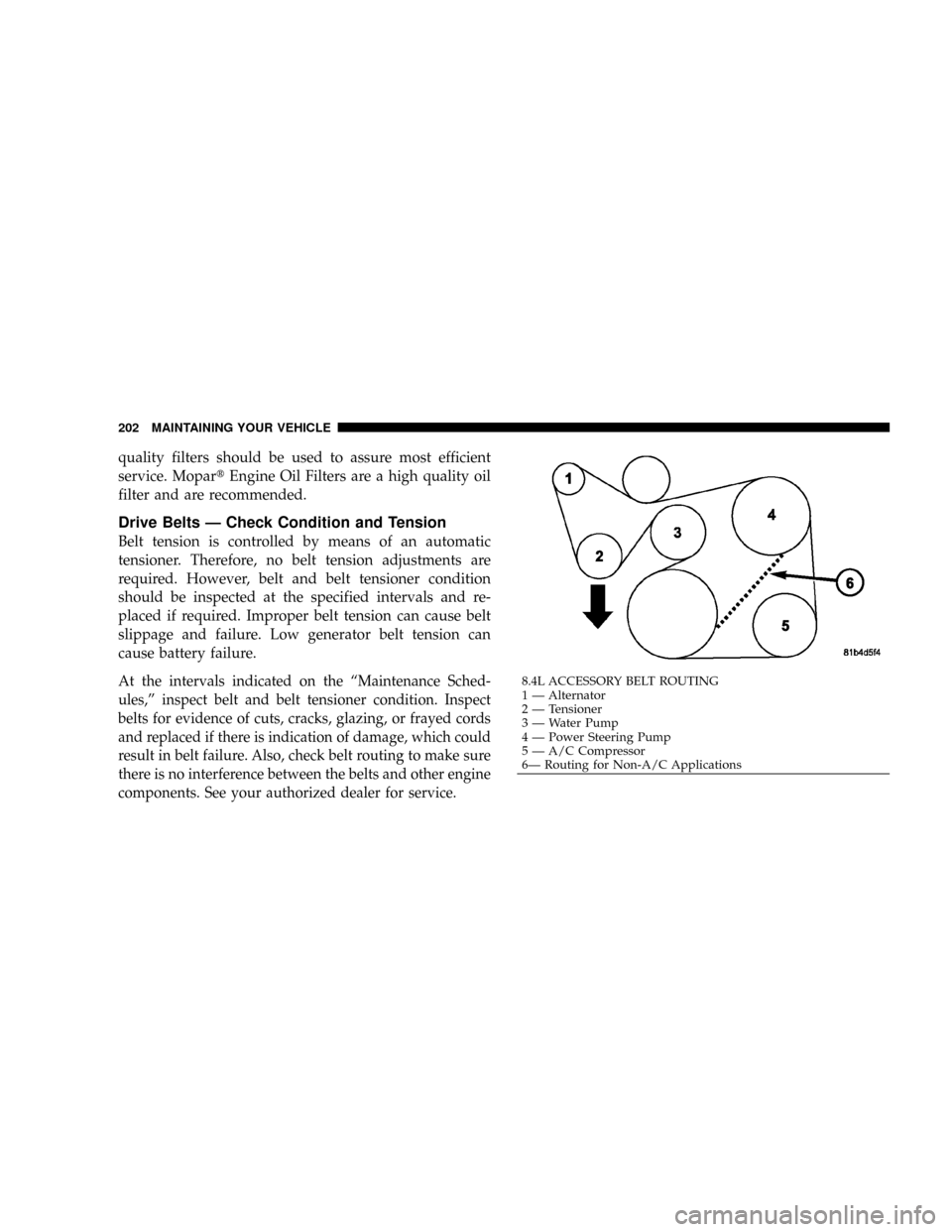
quality filters should be used to assure most efficient
service. MopartEngine Oil Filters are a high quality oil
filter and are recommended.
Drive Belts Ð Check Condition and Tension
Belt tension is controlled by means of an automatic
tensioner. Therefore, no belt tension adjustments are
required. However, belt and belt tensioner condition
should be inspected at the specified intervals and re-
placed if required. Improper belt tension can cause belt
slippage and failure. Low generator belt tension can
cause battery failure.
At the intervals indicated on the ªMaintenance Sched-
ules,º inspect belt and belt tensioner condition. Inspect
belts for evidence of cuts, cracks, glazing, or frayed cords
and replaced if there is indication of damage, which could
result in belt failure. Also, check belt routing to make sure
there is no interference between the belts and other engine
components. See your authorized dealer for service.8.4L ACCESSORY BELT ROUTING
1 Ð Alternator
2 Ð Tensioner
3 Ð Water Pump
4 Ð Power Steering Pump
5 Ð A/C Compressor
6Ð Routing for Non-A/C Applications 202 MAINTAINING YOUR VEHICLE
Page 204 of 303

Spark Plugs
Spark plugs must fire properly to assure engine perfor-
mance and emission control. New plugs should be in-
stalled at the specified mileage. The entire set should be
replaced if there is any malfunction due to a faulty spark
plug. Malfunctioning spark plugs can damage the cata-
lytic converter. Refer to ªFluids, Lubricants, and Genuine
Partsº in this section for the proper type of spark plug for
use in your vehicle.
Engine Air Cleaner Filter
For normal driving conditions, inspect and replace the
engine air cleaner filter at the intervals shown on Sched-
ule ªA.º For vehicles driven frequently in dusty or under
severe conditions, inspect and replace the engine air
cleaner filter at the intervals shown on Schedule ªB.º
WARNING!
The air induction system (air cleaner, hoses, etc) can
provide a measure of protection in the case of engine
backfire. Do not remove the air induction system (air
cleaner, hoses, etc) unless such removal is necessary
for repair or maintenance. Make sure that no one is
near the engine compartment before starting the
vehicle with the air induction system (air cleaner,
hoses, etc) removed. Failure to do so can result in
serious personal injury.
MAINTAINING YOUR VEHICLE 203
7
Page 205 of 303

Fuel Filter
The fuel filter is a part of the fuel module and it does not
require maintenance.
Catalytic Converter
The catalytic converter requires the use of unleaded fuel
only. Leaded gasoline will destroy the effectiveness of the
catalyst as an emission control device.
Under normal operating conditions, the catalytic con-
verter will not require maintenance. However, it is im-
portant to keep the engine properly tuned to assure
proper catalyst operation and prevent possible catalyst
damage.
CAUTION!
Damage to the catalytic converter can result if your
vehicle is not kept in proper operating condition.
Have your vehicle serviced promptly in the event of
engine malfunction, particularly when involving en-
gine misfire or other apparent loss of performance.
Continued operation of your vehicle with a severe
malfunction could cause the converter to overheat,
resulting in possible damage to the converter and the
vehicle.
NOTE:Intentional tampering with emissions control
systems can result in civil penalties being assessed
against you.
204 MAINTAINING YOUR VEHICLE
Page 206 of 303
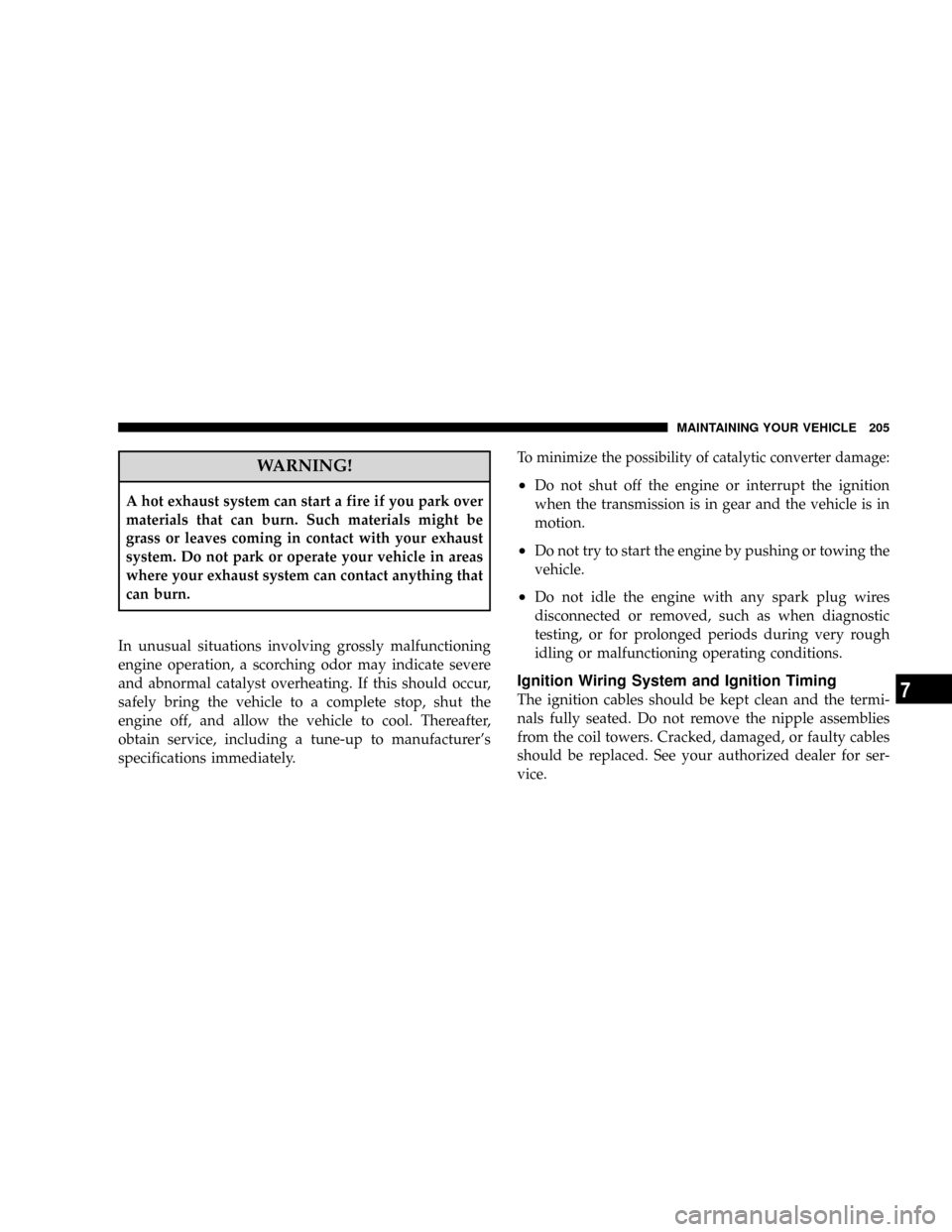
WARNING!
A hot exhaust system can start a fire if you park over
materials that can burn. Such materials might be
grass or leaves coming in contact with your exhaust
system. Do not park or operate your vehicle in areas
where your exhaust system can contact anything that
can burn.
In unusual situations involving grossly malfunctioning
engine operation, a scorching odor may indicate severe
and abnormal catalyst overheating. If this should occur,
safely bring the vehicle to a complete stop, shut the
engine off, and allow the vehicle to cool. Thereafter,
obtain service, including a tune-up to manufacturer's
specifications immediately.
To minimize the possibility of catalytic converter damage:
²Do not shut off the engine or interrupt the ignition
when the transmission is in gear and the vehicle is in
motion.
²Do not try to start the engine by pushing or towing the
vehicle.
²Do not idle the engine with any spark plug wires
disconnected or removed, such as when diagnostic
testing, or for prolonged periods during very rough
idling or malfunctioning operating conditions.
Ignition Wiring System and Ignition Timing
The ignition cables should be kept clean and the termi-
nals fully seated. Do not remove the nipple assemblies
from the coil towers. Cracked, damaged, or faulty cables
should be replaced. See your authorized dealer for ser-
vice.
MAINTAINING YOUR VEHICLE 205
7
Page 207 of 303
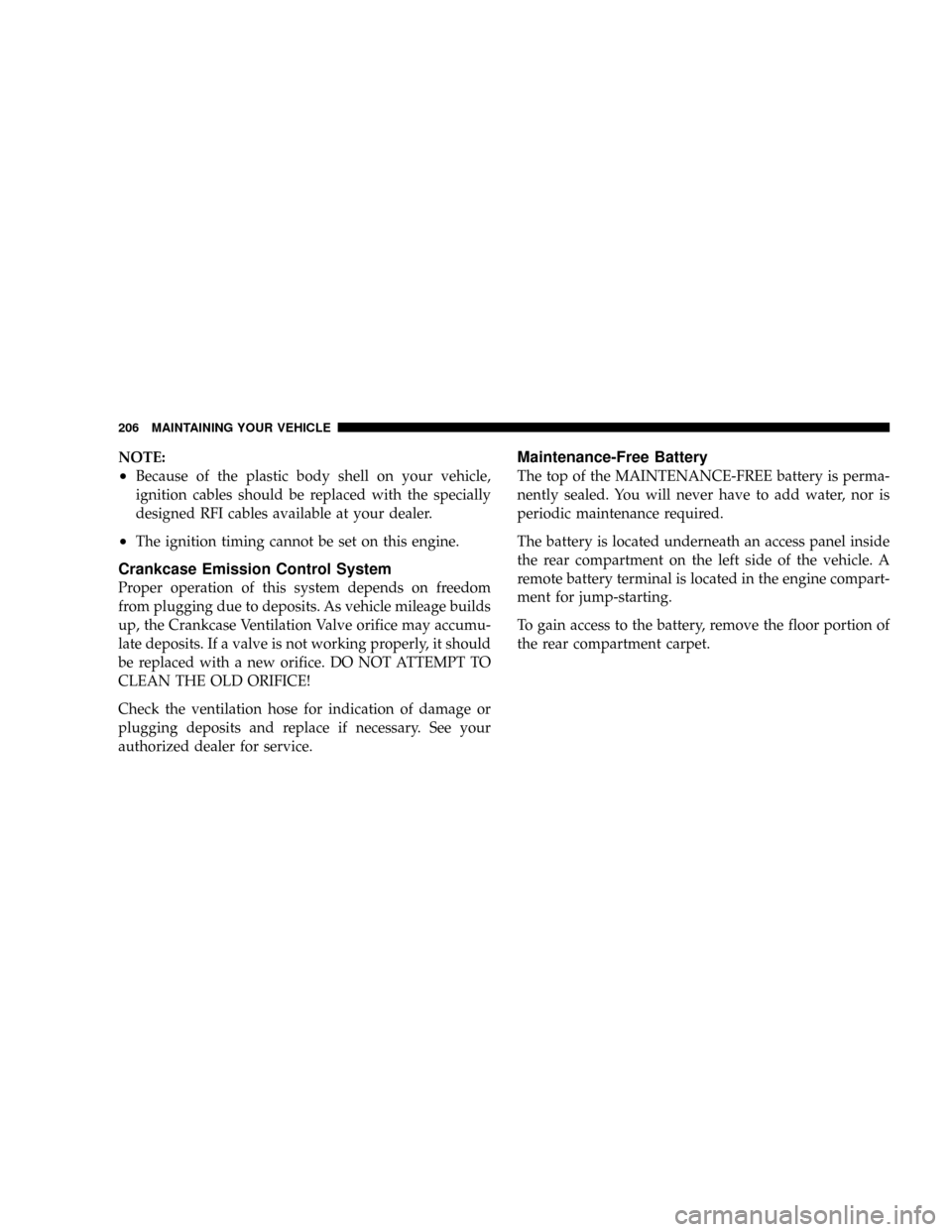
NOTE:
²Because of the plastic body shell on your vehicle,
ignition cables should be replaced with the specially
designed RFI cables available at your dealer.
²The ignition timing cannot be set on this engine.
Crankcase Emission Control System
Proper operation of this system depends on freedom
from plugging due to deposits. As vehicle mileage builds
up, the Crankcase Ventilation Valve orifice may accumu-
late deposits. If a valve is not working properly, it should
be replaced with a new orifice. DO NOT ATTEMPT TO
CLEAN THE OLD ORIFICE!
Check the ventilation hose for indication of damage or
plugging deposits and replace if necessary. See your
authorized dealer for service.
Maintenance-Free Battery
The top of the MAINTENANCE-FREE battery is perma-
nently sealed. You will never have to add water, nor is
periodic maintenance required.
The battery is located underneath an access panel inside
the rear compartment on the left side of the vehicle. A
remote battery terminal is located in the engine compart-
ment for jump-starting.
To gain access to the battery, remove the floor portion of
the rear compartment carpet.
206 MAINTAINING YOUR VEHICLE
Page 211 of 303

Battery Save Feature
The Battery Save feature conserves battery power when
storing the vehicle. It allows for up to 3 months of storage
time without losing radio and engine controller memory.
Using this feature is an alternative to disconnecting the
battery.
NOTE:This vehicle is designed to sit in storage with a
fully charged battery for up to 30 days. If you plan to
store the vehicle longer than 30 days, we recommend
doing one of the following:
²Disconnect the battery.
²Use the battery charger.
²Put the vehicle into Battery Save mode (3-month
charge).
To Activate the Battery Save Feature:
1. Insert the key into the ignition switch.2. Cycle the ignition switch from OFF/LOCK to ACC
four times. Leave the switch in the OFF/LOCK position
after the fourth cycle.
3. Push the driver's Power Door Lock switch in the UP
direction. A single chime will sound and the horn will
chirp to indicate that the process has begun.
Ignition Key Positions
210 MAINTAINING YOUR VEHICLE
Page 213 of 303

Air Conditioner Maintenance
For best possible performance, your air conditioner
should be checked and serviced by an Authorized Dealer
at the start of each warm season. This service should
include cleaning of the condenser fins and a performance
test. Drive belt tension should also be checked at this
time.
NOTE:If A/C performance seems less then normal,
check the front of the A/C condenser (located in front of
the radiator) for dirt and insect accumulation. Clean with
a gentle water spray as required. Front end fascia protec-
tors may reduce air flow to the condenser and radiator,
reducing A/C and engine cooling performance.WARNING!
²Use only refrigerants and compressor lubricants
approved by the manufacturer for your air condi-
tioning system. Some unapproved refrigerants are
flammable and can explode, injuring you. Other
unapproved refrigerants or lubricants can cause
the system to fail, requiring costly repairs. Refer to
Section 3 of the Warranty Information book for
further warranty information.
²The air conditioning system contains refrigerant
under high pressure. To avoid risk of personal
injury or damage to the system, adding refrigerant
or any repair requiring lines to be disconnected
should be done by an experienced technician.
212 MAINTAINING YOUR VEHICLE
Page 214 of 303
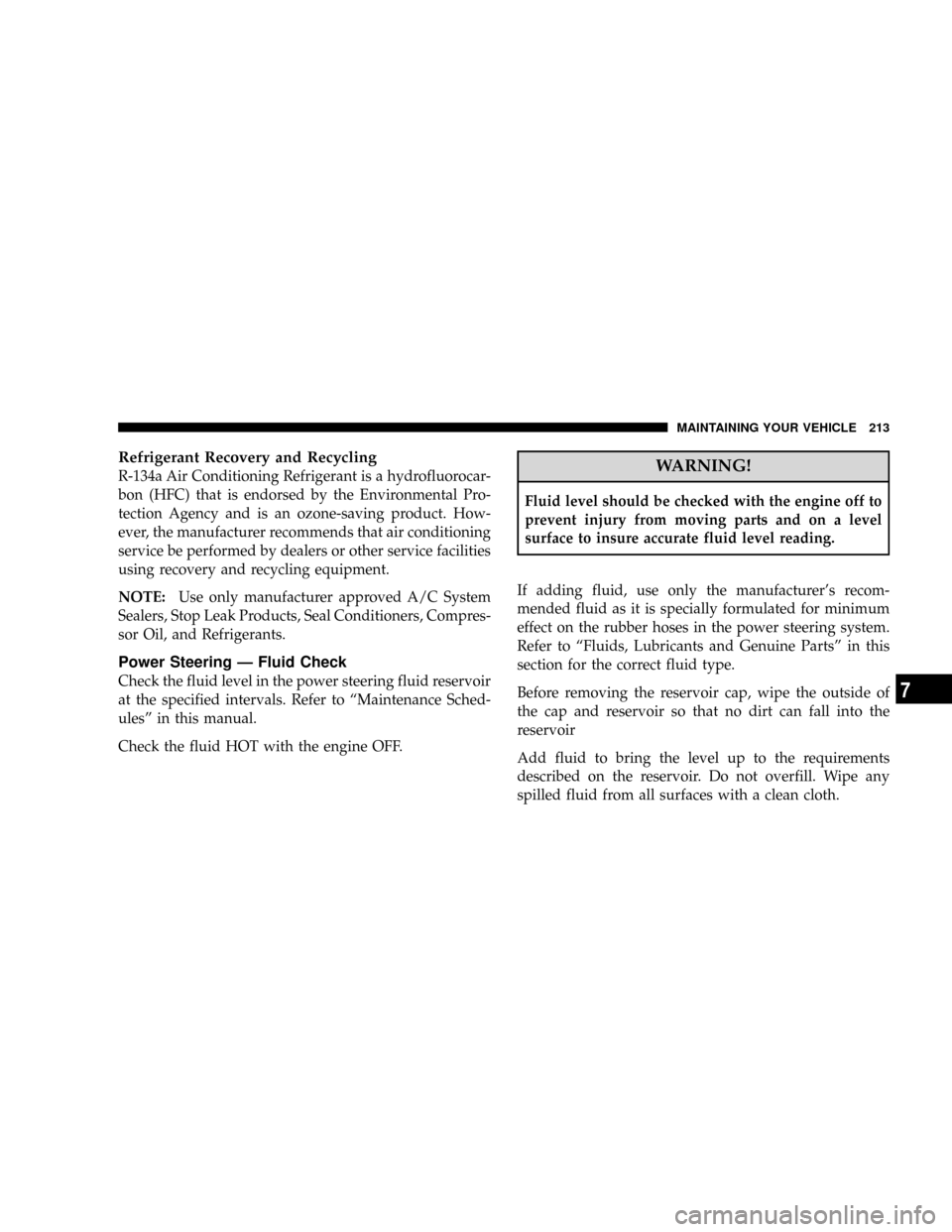
Refrigerant Recovery and Recycling
R-134a Air Conditioning Refrigerant is a hydrofluorocar-
bon (HFC) that is endorsed by the Environmental Pro-
tection Agency and is an ozone-saving product. How-
ever, the manufacturer recommends that air conditioning
service be performed by dealers or other service facilities
using recovery and recycling equipment.
NOTE:Use only manufacturer approved A/C System
Sealers, Stop Leak Products, Seal Conditioners, Compres-
sor Oil, and Refrigerants.
Power Steering Ð Fluid Check
Check the fluid level in the power steering fluid reservoir
at the specified intervals. Refer to ªMaintenance Sched-
ulesº in this manual.
Check the fluid HOT with the engine OFF.
WARNING!
Fluid level should be checked with the engine off to
prevent injury from moving parts and on a level
surface to insure accurate fluid level reading.
If adding fluid, use only the manufacturer's recom-
mended fluid as it is specially formulated for minimum
effect on the rubber hoses in the power steering system.
Refer to ªFluids, Lubricants and Genuine Partsº in this
section for the correct fluid type.
Before removing the reservoir cap, wipe the outside of
the cap and reservoir so that no dirt can fall into the
reservoir
Add fluid to bring the level up to the requirements
described on the reservoir. Do not overfill. Wipe any
spilled fluid from all surfaces with a clean cloth.
MAINTAINING YOUR VEHICLE 213
7
Page 215 of 303

WARNING!
Overfilling the power steering fluid reservoir can
result in spilling power steering fluid on hot engine
parts and the power steering fluid catching fire.
Front & Rear Suspension Ball Joints
This vehicle has suspension ball joints that require peri-
odic inspection and lubrication.
Inspection
The ball joints should be inspected whenever other
service or maintenance is performed on the vehicle.
Damaged seals should be replaced to prevent leakage or
contamination of the grease. If there is any movement
within the ball joint, the knuckle or control arm must be
replaced, as the ball joints are not serviceable by them-
selves. See your authorized dealer for service.
Lubrication
The ball joints are lubricated at the factory with special
grease. Therefore, when lubricating the ball joints, use
only special long life chassis grease such as Multi-
Mileage Lubricant, which is intended for this purpose.
Refer to the ªMaintenance Schedulesº in this manual for
the specified lubrication intervals.
Steering Linkage
There are two tie rod end ball joints that require periodic
inspection.
Inspection
The ball joint seals on the tie rod ends should be
inspected whenever other service or maintenance is
performed on the vehicle. Damaged seals should be
replaced to prevent leakage or contamination of the
grease. If damaged, the tie rod end must be replaced, as
the seals are not serviceable by themselves. See your
authorized dealer for service.
214 MAINTAINING YOUR VEHICLE
Page 218 of 303
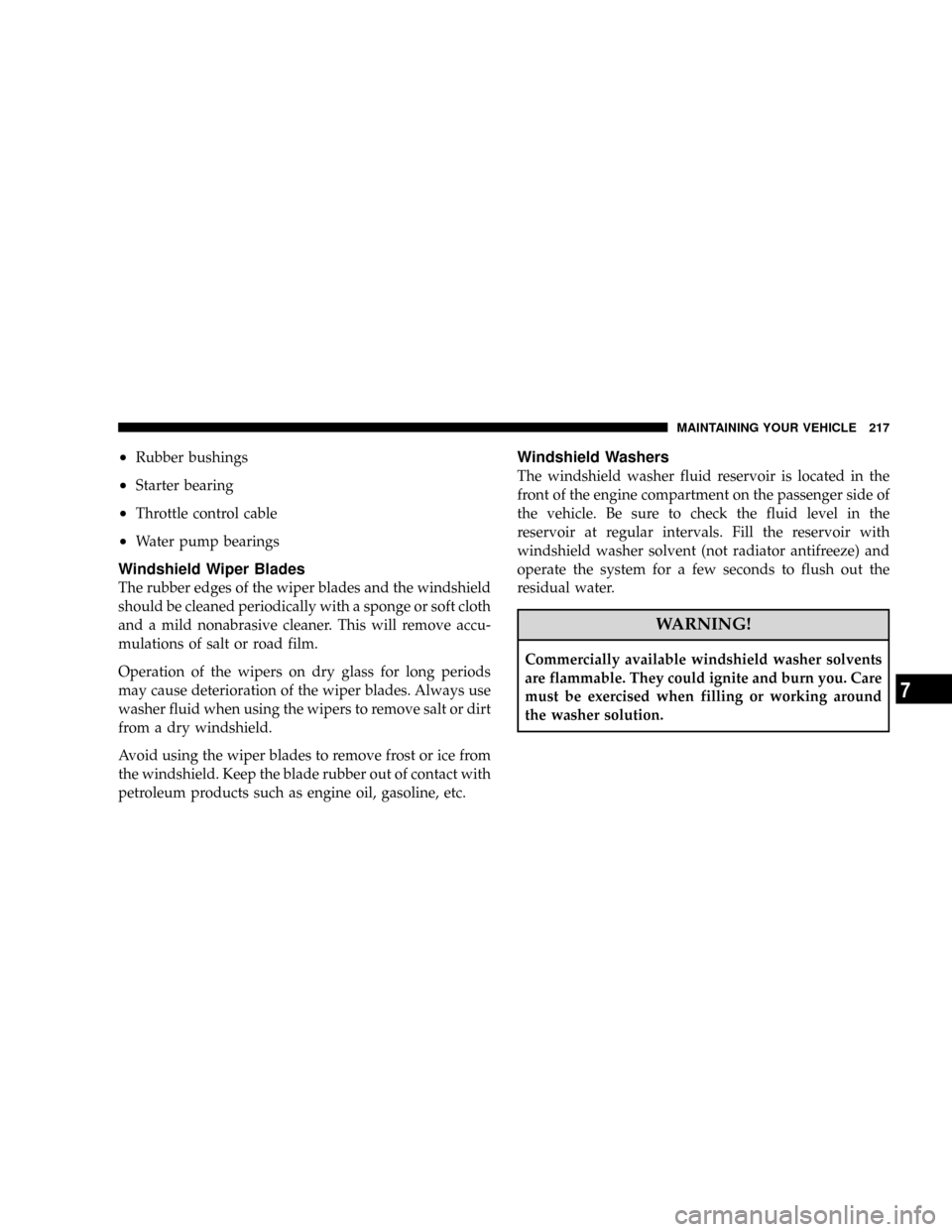
²Rubber bushings
²Starter bearing
²Throttle control cable
²Water pump bearings
Windshield Wiper Blades
The rubber edges of the wiper blades and the windshield
should be cleaned periodically with a sponge or soft cloth
and a mild nonabrasive cleaner. This will remove accu-
mulations of salt or road film.
Operation of the wipers on dry glass for long periods
may cause deterioration of the wiper blades. Always use
washer fluid when using the wipers to remove salt or dirt
from a dry windshield.
Avoid using the wiper blades to remove frost or ice from
the windshield. Keep the blade rubber out of contact with
petroleum products such as engine oil, gasoline, etc.
Windshield Washers
The windshield washer fluid reservoir is located in the
front of the engine compartment on the passenger side of
the vehicle. Be sure to check the fluid level in the
reservoir at regular intervals. Fill the reservoir with
windshield washer solvent (not radiator antifreeze) and
operate the system for a few seconds to flush out the
residual water.
WARNING!
Commercially available windshield washer solvents
are flammable. They could ignite and burn you. Care
must be exercised when filling or working around
the washer solution.
MAINTAINING YOUR VEHICLE 217
7